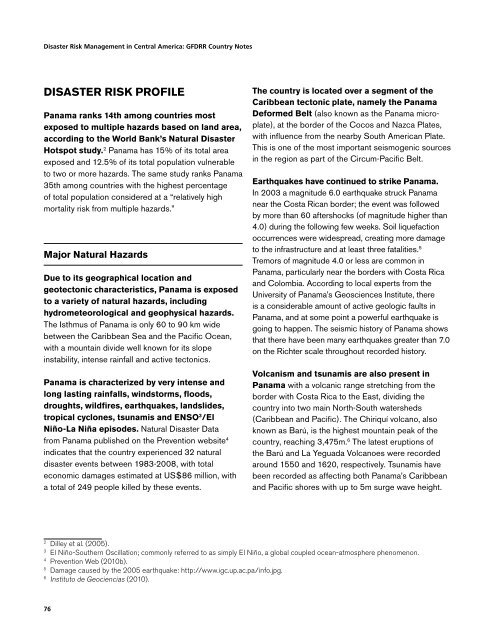Disaster Risk Management in Central America: GFDRR Country Notes
Disaster Risk Management in Central America: GFDRR Country Notes
Disaster Risk Management in Central America: GFDRR Country Notes
You also want an ePaper? Increase the reach of your titles
YUMPU automatically turns print PDFs into web optimized ePapers that Google loves.
<strong>Disaster</strong> <strong>Risk</strong> <strong>Management</strong> <strong>in</strong> <strong>Central</strong> <strong>America</strong>: <strong>GFDRR</strong> <strong>Country</strong> <strong>Notes</strong><br />
disaster risk profile<br />
Panama ranks 14th among countries most<br />
exposed to multiple hazards based on land area,<br />
accord<strong>in</strong>g to the World Bank’s Natural <strong>Disaster</strong><br />
Hotspot study. 2 Panama has 15% of its total area<br />
exposed and 12.5% of its total population vulnerable<br />
to two or more hazards. The same study ranks Panama<br />
35th among countries with the highest percentage<br />
of total population considered at a “relatively high<br />
mortality risk from multiple hazards.”<br />
Major Natural Hazards<br />
Due to its geographical location and<br />
geotectonic characteristics, Panama is exposed<br />
to a variety of natural hazards, <strong>in</strong>clud<strong>in</strong>g<br />
hydrometeorological and geophysical hazards.<br />
The Isthmus of Panama is only 60 to 90 km wide<br />
between the Caribbean Sea and the Pacific Ocean,<br />
with a mounta<strong>in</strong> divide well known for its slope<br />
<strong>in</strong>stability, <strong>in</strong>tense ra<strong>in</strong>fall and active tectonics.<br />
Panama is characterized by very <strong>in</strong>tense and<br />
long last<strong>in</strong>g ra<strong>in</strong>falls, w<strong>in</strong>dstorms, floods,<br />
droughts, wildfires, earthquakes, landslides,<br />
tropical cyclones, tsunamis and ENSO 3 /El<br />
Niño-La Niña episodes. Natural <strong>Disaster</strong> Data<br />
from Panama published on the Prevention website 4<br />
<strong>in</strong>dicates that the country experienced 32 natural<br />
disaster events between 1983-2008, with total<br />
economic damages estimated at US$86 million, with<br />
a total of 249 people killed by these events.<br />
The country is located over a segment of the<br />
Caribbean tectonic plate, namely the Panama<br />
Deformed Belt (also known as the Panama microplate),<br />
at the border of the Cocos and Nazca Plates,<br />
with <strong>in</strong>fluence from the nearby South <strong>America</strong>n Plate.<br />
This is one of the most important seismogenic sources<br />
<strong>in</strong> the region as part of the Circum-Pacific Belt.<br />
Earthquakes have cont<strong>in</strong>ued to strike Panama.<br />
In 2003 a magnitude 6.0 earthquake struck Panama<br />
near the Costa Rican border; the event was followed<br />
by more than 60 aftershocks (of magnitude higher than<br />
4.0) dur<strong>in</strong>g the follow<strong>in</strong>g few weeks. Soil liquefaction<br />
occurrences were widespread, creat<strong>in</strong>g more damage<br />
to the <strong>in</strong>frastructure and at least three fatalities. 5<br />
Tremors of magnitude 4.0 or less are common <strong>in</strong><br />
Panama, particularly near the borders with Costa Rica<br />
and Colombia. Accord<strong>in</strong>g to local experts from the<br />
University of Panama’s Geosciences Institute, there<br />
is a considerable amount of active geologic faults <strong>in</strong><br />
Panama, and at some po<strong>in</strong>t a powerful earthquake is<br />
go<strong>in</strong>g to happen. The seismic history of Panama shows<br />
that there have been many earthquakes greater than 7.0<br />
on the Richter scale throughout recorded history.<br />
Volcanism and tsunamis are also present <strong>in</strong><br />
Panama with a volcanic range stretch<strong>in</strong>g from the<br />
border with Costa Rica to the East, divid<strong>in</strong>g the<br />
country <strong>in</strong>to two ma<strong>in</strong> North-South watersheds<br />
(Caribbean and Pacific). The Chiriquí volcano, also<br />
known as Barú, is the highest mounta<strong>in</strong> peak of the<br />
country, reach<strong>in</strong>g 3,475m. 6 The latest eruptions of<br />
the Barú and La Yeguada Volcanoes were recorded<br />
around 1550 and 1620, respectively. Tsunamis have<br />
been recorded as affect<strong>in</strong>g both Panama’s Caribbean<br />
and Pacific shores with up to 5m surge wave height.<br />
2<br />
Dilley et al. (2005).<br />
3<br />
El Niño-Southern Oscillation; commonly referred to as simply El Niño, a global coupled ocean-atmosphere phenomenon.<br />
4<br />
Prevention Web (2010b).<br />
5<br />
Damage caused by the 2005 earthquake: http://www.igc.up.ac.pa/<strong>in</strong>fo.jpg.<br />
6<br />
Instituto de Geociencias (2010).<br />
76
















